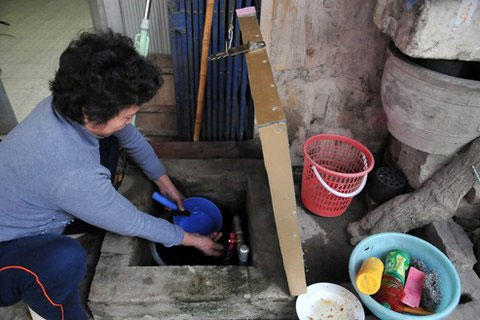Hanoi underground water 'arsenic contamination' to foreign newspapers
Arsenic (Arsenic) has infiltrated groundwater, which is used as a source of drinking water for Hanoi people, AFP cites scientific research and warns, this phenomenon also occurs elsewhere.
The AFP, which led the study published in Nature, said the team conducted many tests around Van Phuc village, Ha Dong, 10 km southeast of central Hanoi. Here, experts measured water samples taken from household wells at about 40m, and found arsenic contamination levels to be quite high.
West of Van Phuc village, wells with arsenic concentrations below 10 micrograms in a liter of water are much lower than the standards of the World Health Organization (WHO). In the east of the village, arsenic concentration is 10 to 50 times higher.
From the survey, the scientific group stated that there are two levels of water in Van Phuc. One floor is in sediment layer from about 5,000 years and high arsenic infection. Another safe water layer is about 12,000 years old. Hanoi's demand for water is increasing, leading to the over-exploitation of this water layer, causing water from the arsenic-infiltrating water and the Red River to flow.

Many households in Hanoi are using arsenic-contaminated water.(Artwork: Hoang Ha)
According to the study of arsenic contaminated water, about 120 m has been increased into the safe water layer."Fortunately, it doesn't spread as quickly as we fear," said Professor Alexander van Geen, at Columbia University in New York.
However, scientists believe that Hanoi people should not be too worried about health by groundwater before coming to each treated household. What scientists worry about is that households use drinking water from contaminated wells.
Ms. Pham Thi Kim Trang (Center for Environmental Technology and Sustainable Development, National University of Hanoi), a member of the research team said that there were a number of programs to support Van Phuc area to overcome the current situation. ."However, if people in the city continue to exploit more groundwater, the arsenic problem will become more serious in the coming time," AFP quoted Trang as saying in the press release.
Trang also noted that the expansion to develop city suburbs makes many people dig wells and use untreated water.
Last year, Professor Tran Hong Con (Faculty of Chemistry, University of Natural Sciences, National University of Hanoi) and colleagues announced "map" the level of arsenic contamination in groundwater and Hanoi domestic water from in 1998. Results showed that about 30% of survey wells had a level of arsenic contamination of 0.05 mg / liter, 50% of water samples exceeded the permitted level of 0.01mg / liter.
For supplied water, ie treated underground water at water plants, after taking thousands of samples from plants of Ha Dinh, Phap Van, Yen Phu, testing has an amount of arsenic exceeding the permitted level. clearly, higher than the rate of 0.01mg / liter.
Experts warn, arsenic in high concentrations can cause cardiovascular disease, liver, kidney and cancer.
- Southeast Asia has a high rate of arsenic poisoning in the country
- How much arsenic in water is dangerous?
- Filter water contaminated with arsenic
- Filtration of arsenic-contaminated water
- Drinking dangerous arsenic water like smoking
- To know if the water is contaminated with arsenic
- Panic because of water poisoning
- Found moss that can filter out arsenic in water
- India develops arsenic detection techniques
- Detection of arsenic-contaminated tap water with a rapid test kit
- Manufacture of arsenic filters in domestic water
- Foreign newspapers write about strange objects 'billions of money' in the belly of a pig
 Is the magnetic North Pole shift dangerous to humanity?
Is the magnetic North Pole shift dangerous to humanity? Washington legalizes the recycling of human bodies into fertilizer
Washington legalizes the recycling of human bodies into fertilizer Lightning stone - the mysterious guest
Lightning stone - the mysterious guest Stunned by the mysterious sunset, strange appearance
Stunned by the mysterious sunset, strange appearance